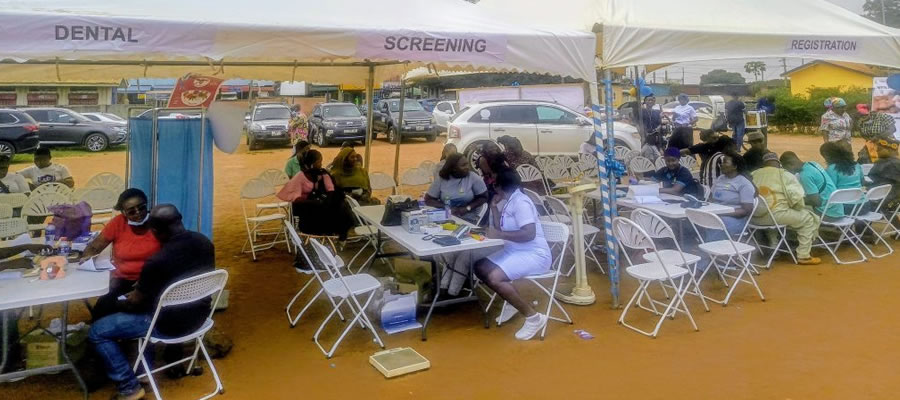

Main Source of Water for drinking and for other domestic use
The availability and accessibility to improved drinking water is an important aspect of the health of household members. The UN Millennium Development Goal (MDG7) is to reduce by half the proportion of people without sustainable access to safe drinking water by 2015 based on 1990 levels. This section examines the various sources of drinking water for the La Nkwantanang Madina Municipality
Source of Water for Drinking and other Domestic Uses
Table 8.10 presents the sources of drinking water and for other domestic purposes. The results show that majority (61.9%) of households in the Municipality depend on sachet water as their main source of drinking water. This is followed by about one-tenth (11.9 %) drinking from pipe-borne water outside the dwelling unit and the same proportion depending on tanker supply/ vendor. The tankers supply service is more patronized by urban households than rural households (11.7% against 3.1%), whereas sachet water is rather on a higher demand in the rural areas than urban areas (64.0% against 61.5%). This may perhaps be due to inadequate supply of pipe-borne water; evident in table 8.10, rural (4.2%) and urban (8.5%). In additional, the use of sachet water for drinking could have some health implications since some of them were not produced under hygienic conditions.
Main sources of water for other domestic use for household
With regards to water for other domestic purposes, a little more than one-third (37.7%) of households in the municipality are either connected to the pipe-borne water outside dwelling (24.0%) or pipe-borne water inside dwelling (13.7%). Again, about one-third (33.7%) rely on tanker supply/vendor, while 12.3 percent uses water from protected well. Less than one percent of households depend on Rain water (0.5%), protected spring (0.2%), unprotected spring (0.2%), River/Stream (0.3%), and Dugout/Pond/Lake/Dam/Canal (0.2%).
From Figure 8.3, the proportions of household that depend on tanker supply (36.7%), pipe-borne outside (24.6%) and inside (14.8%) dwelling for water for domestic purposes are higher relative to that of rural households. However, rural households have higher proportions that depend on bore-hole/ pump/ tube well (17.8%), Public tap / standpipe (13.1%) and protected well (18.2%) compared to that of urban households (7.0 %, 3.7, and 11.1% respectively).
Bathing and Toilet Facilities
Toilet Facilities
An efficient and hygienic method of human waste disposal available in a dwelling unit provides a critical indicator for assessing sanitary condition of the unit and is an indirect measure of the socio-economic status of a household (GSS, 2012).
Bathing facility type in the Municipality is described in Table 8.11. About one-third of the people (32.1%) in La Nkwantanang Madina Municipality use shared separate bathroom in same house, while 31.1 percent of households used own bathroom for exclusive use. A significantnumber of households used shared open cubicle (24.6%), public bathroom (3.9%) and private open cubicles (2.0%) as bathing facilities in the Municipality.
In terms of rural-urban differentials, the results revealed that about one-third (34.3%) of urban households used ‘shared separate bathroom in the same house as their bathing facility and 20.3 percent of households in rural households used same. Own bathroom for exclusive use (Rural: 33.9% and Urban: 30.6%) and shared cubicle (Rural: 30.4% and Urban: 23.5%) are more commonly used in rural than urban areas.
Bathing Facilities
Table 8.11 further presents the distribution of toilet facility type in the Municipality. A higher percentage of households used WC (38.8 %) in the Municipality but public toilet (41.6%) and W.C. (31.9%) were the most common toilet facilities in the region. The use of KVIP (23.4%), public toilet (17.2%) and pit latrine (13.2%) are also significant. A total of 1,923 households representing 6.7 percent of the households in the Municipality have no toilet facility and therefore used the bush or beach as places of convenience.
Besides water closet, the use of public toilets, KVIPs and bush or beaches are all unhygienic facilities since they were mostly used by multiple households or the public. The use of unhygienic facilities coupled with poor hygiene practices co
Figure 8.3 shows the type of toilet facilities used by households by locality. The figure shows that, use of pit latrine is more common among rural households (27.1%) than urban households (10.5%), while among the urban households other toilet facilities like KVIP, W.C and public toilet are more commonly used compared to as observed in rural households
Method of Waste Disposal
Solid waste disposal
Table 8.12 presents the various methods by which solid and liquid waste was disposed of by households in the Municipality. It shows that 67.9 percent of households collected their solid waste, 12.1 percent dispose theirs through public dump (container), while 1.1 percent dumped indiscriminately. A similar pattern of solid waste disposal is observed in all the localities. However, indiscriminate disposal of solid waste is more common in the rural areas compared to urban areas (3.2% against 0.7%) in Municipality.
Liquid waste disposal
According to Table 8.12, while only 8.7 percent of the entire households in the municipality dispose their liquid waste through the sewage system, almost seventy percent dispose liquid waste either by throwing into gutters (26.2%), throwing onto compounds (22.3%) or throwing onto the streets (21.0%). With regard to type of locality, while throwing of liquid waste into gutter (28.8%) is the commonest method of disposal of liquid waste, majority (46.5%) of rural households resort
throwing of liquid waste unto compounds. It can be concluded that liquid waste was improperly disposed of in the Municipality.
Date Created : 12/5/2017 6:26:10 AM









 facebook
facebook
 twitter
twitter
 Youtube
Youtube
 +233 593 831 280
+233 593 831 280 0800 430 430
0800 430 430 GPS: GE-231-4383
GPS: GE-231-4383 info@ghanadistricts.com
info@ghanadistricts.com Box GP1044, Accra, Ghana
Box GP1044, Accra, Ghana